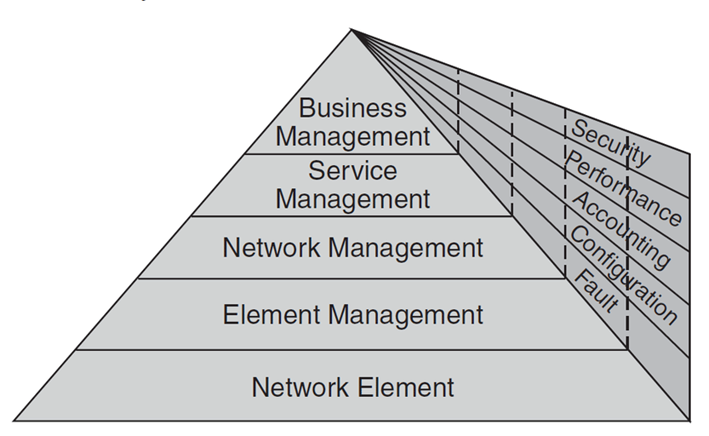Customers expect uninterrupted network connectivity from their telco services providers so telcos have to grapple with the enormous task of sustaining peak network performance for every minute of every day. This involves managing the sophisticated mix of physical, logical and virtual resources utilised by today’s networks, all while adapting to a constantly evolving customer / service landscape.
Network Management Systems (NMS) and Operational Support Systems (OSS) are responsible for amalgamating network functions into a single, coherent solution, providing end-to-end visibility and control over network operations. As much as the networks under management continue to evolve going forward, there’s still a need to look back into the past as well when designing and implementing OSS.
Interaction with EMS and the pyramid principle
We often need to draw upon the principles of the Telecommunications Management Network (TMN) pyramid and the FCAPS model when interacting with Network Element Management Systems (EMS). It’s still relatively common for EMS to be designed using FCAPS-like frameworks for data sharing with OSS/NMS systems.
Whilst not actually represented in any of the standards materials, the diagram below provides a combined view of TMN (front face of the pyramid) and FCAPS (side face).

Source: https://www.researchgate.net/figure/TMN-Reference-Model-Refined-with-FCAPS-8_fig2_271376027
The TMN Pyramid
The TMN Model is outlined in the International Telecommunication Union (ITU-T) recommendation M.3010, which was first released in 1992. Within M.3010, the Logical Layered Architecture (LLA) is a concept designed to abstract different management functionalities / responsibilities as follows:
- Business Management (BML): This is the upper layer of the pyramid, responsible for the overall business strategy, planning, and monitoring of the telecom network.
- Service Management (SML): The next layer from the top deals with the management of services provided to customers, including service configuration, activation and quality assurance.
- Network Management (NML): The middle layer of the pyramid focuses on the management of the network as a whole, including the optimisation of network resources and coordination of network activities.
- Element Management (EML): This layer is responsible for collectively managing individual network elements (NEs) – the devices and systems that make up the network, such as routers, switches, and servers – and their inter-connectivity.
- Network Element (NE): The final layer of the pyramid represents the actual physical and logical devices and systems that make up the network.
Many refer to these layers as “The TMN pyramid,” in alignment with the front face of the pyramid above. OSS and BSS solutions provide functionality that mostly resides within the BM and SM layers, but also incorporate aspects of the NML.
FCAPS (Fault, Configuration, Accounting, Performance, Security)
The FCAPS model is another network management framework developed by the ITU, this time in the M.3400 series of recommendations developed the 1990s. It is rarely considered in OSS or BSS designs these days. However, it is often considered by EMS designers to manage network domains, particularly when sharing information upwards to OSS/BSS via their northbound interfaces (NBIs). The FCAPS model comprises of:
- Fault Management (FM): Proactive monitoring of network performance allows for immediate detection and rectification of faults, minimising downtime and service disruption.
- Configuration Management (CM): Centralised control of network configuration and inventory aids in managing and optimising network resources, contributing to overall network efficiency.
- Accounting Management (AM): Accurate tracking and billing of service usage, ensures fair charges are assigned to customers and facilitates revenue assurance for operators.
- Performance Management (PM): Real-time performance monitoring enables operators to observe and maintain high levels of network availability and reliability, enhancing customer satisfaction.
- Security Management (SM): Safeguards network integrity, protecting against the threat of cyber criminals to ensure data protection and privacy.
Modern Network Management
TMN and FCAPS were designed in an era where physical and logical resources existed, but they certainly didn’t consider network virtualisation or the convergence of modern IT approaches with telco networks. Yet integrated OSS and NMS, built upon the principles of the TMN pyramid and FCAPS model, still provide a unified, end-to-end view of network operations. They use modular concepts to divide responsibilities, simplify complexity, streamline processes and provide valuable insights. This enables telecom operators to manage resources efficiently, maintain network performance and deliver high-quality / highly-reliable services to customers.
As we progress further into a future dominated by network virtualisation including 5G, IoT, and other disruptive technologies, the role of carefully partitioned but integrated network management systems will only become more pivotal.
At SunVizion, we continue to recognise the transformative nature of modern networks and approaches being transferred across from the IT industry. However, we also acknowledge that our solutions continue to be designed to help telecom operators navigate the intricacies of network management, operational efficiency and service excellence, just as they were in the days of FCAPS and TMN. We continue to see hints of the past in the data and interfaces we work with even as we remain committed to powering the future of telecom operations.